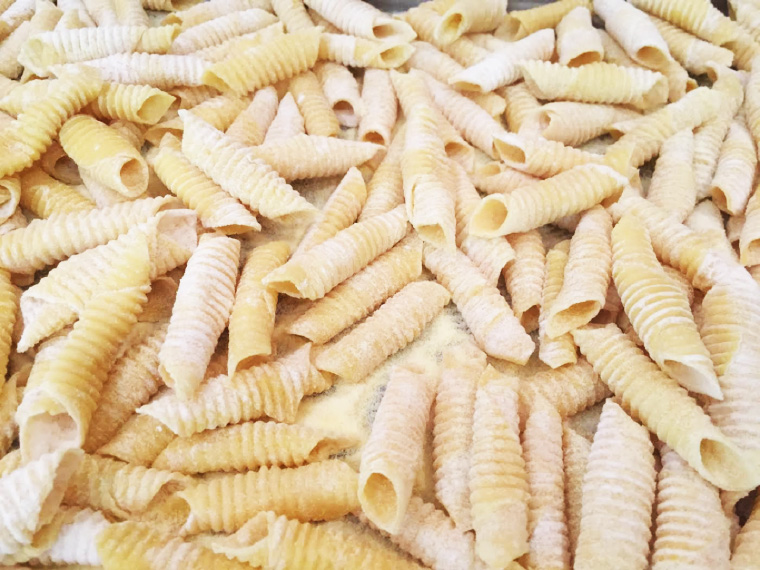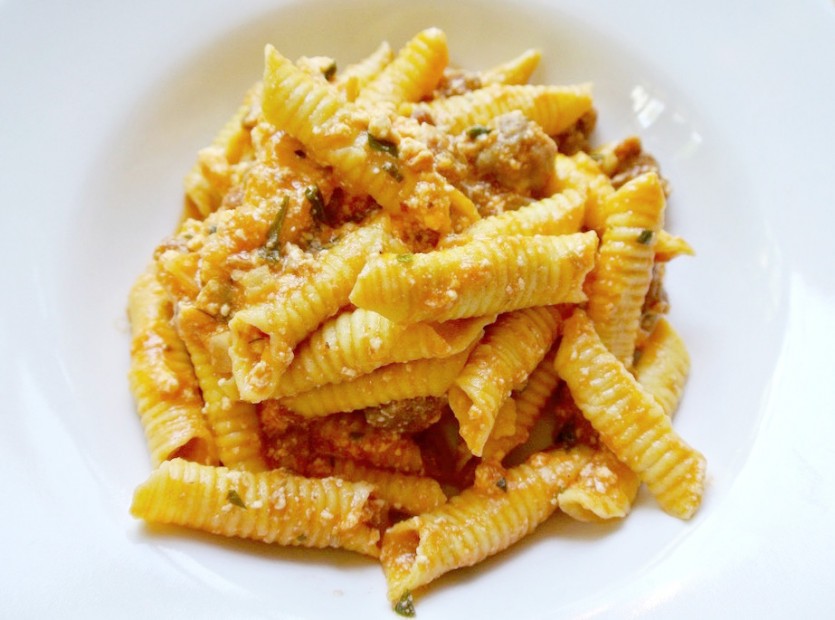I’m trying to figure out why it took me so long to make garganelli. I think it was because a cookbook I have said to make it on a clean men’s hair comb, which just sounded like a bad idea. Once I found out you can easily make it with a butter board (also used for making gnocchi), I was on my way.
To make garganelli, all you have to do is make a standard pasta dough and roll it out to a slightly thick sheet, cut it into 1 ½ inch squares, grab a pencil or thick skewer and your butter board and roll, baby, roll. More details follow below.
Garganelli is traditionally prepared with Ragù Bolognese or other slow-cooked sauces. I used a speedy sausage and fennel sauce that grabbed on to the little ridges of the garganelli.
This a great stick-to-your-ribs dinner for a cool autumn night. Take the time to try to make fresh garganelli. It’s a really fun pasta shape. But you can always go with dried penne if you’re in a hurry.
Serves 4 first course servings.
Ingredients and Directions:
For the garganelli:
• 10 ounces of “00” flour
• 4 ounces of semolina flour
• A pinch of salt
• 5 large eggs
For the sauce:
• 2 ounces pancetta, finely diced
• 2 tbsp unsalted butter
2 tbsp extra-virgin olive oil
1 onion, medium-dice
• 1 fennel bulb, core removed and medium dice
• 4 sweet Italian sausages
• 1 tbsp fennel seeds, crushed to a powder in a mortar and pestle
• 2 ounces tomato paste
• 1 cup chicken stock
• ½ cup ricotta cheese
• A small amount of minced parsley
• ½ cup freshly grated Parmigiano-Reggiano cheese

Garganelli pasta
For the garganelli:
Add the flours and salt together. Pour out onto a board and make a well in the center. Break the eggs into the well and, using a fork, whisk the eggs together. Using the fork, begin to draw in the flour from the edges. Switch to your hands when you have a wet paste. Continue to combine in the flour until you have dough the consistency of “play dough”. Add more flour if needed. The dough should not stick to the board. Kneed for about 10 minutes. Wrap in plastic wrap and let rest at room temperature for 20 minutes.
Divide the dough into 4 equal parts. Roll out the dough to #4 on your Kitchenaid stand mixer with the pasta sheet attachment. Roll one strip at a time. Flour both sides of the dough sheet well and cut into 1 ½-inch squares.
Using a butter board and thick skewer or clean pencil, place the square on the butter board in a diamond position. Place the skewer at the base of the diamond and roll the dough away from you, pressing gently to get the ridge pattern in the dough. Once you have the pasta wrapped once around the skewer, use the skewer like a rolling pin to complete the rollup of the dough. Make sure the end is sealed.
Place the pasta on sheet pans and use immediately or freeze.
For the pasta sauce:
In a skillet large enough to hold the cooked pasta, add the diced pancetta over medium-low heat and allow it to render the fat slowly, stirring occasionally. Cook the pancetta very slowly or you’ll just seal in the fat; it should take about 10 minutes.
Add the butter and olive oil. Add the chopped onion and fennel; season with salt and pepper. Cook until both the onion and fennel are soft and translucent.
Cut the sausage out of its casings and crumble it into the skillet. Add the crushed fennel seed. Using a wooden spoon, cook the sausage, breaking it up along the way. Cook until all the pink is gone in the sausage.
Dissolve the tomato paste in the chicken broth and add to the skillet. Raise the heat until the mixture is bubbling and then reduce to low. Season with salt and pepper to taste and cover and simmer on low for about 1 hour.
Season a final time with salt and pepper as needed.
Prepare the pasta:
Bring a pot of salted water to a boil.
With the pasta sauce simmering over low heat, add the ricotta and parsley and mix in, dissolving the ricotta. The sauce should be pretty “tight” at this point – that is, not too watery. If needed, simmer a little longer to dry it out.
Drop the pasta into the boiling water. Once the pasta rises to the surface, cook for one minute.
Drain the pasta but retain a cup or so of the pasta water. Add the pasta to the sauce, add some pasta water and stir to incorporate. The sauce should become like a thick salad dressing. Cook for 30 seconds, stirring gently. Add more pasta water as needed.
Stir in the Parmigiano-Reggiano cheese and serve.
Joe and Michele Becci are a brother and sister team who love all things Italian. Together, from opposite coasts, they co-author the blog OurItalianTable.com.
































